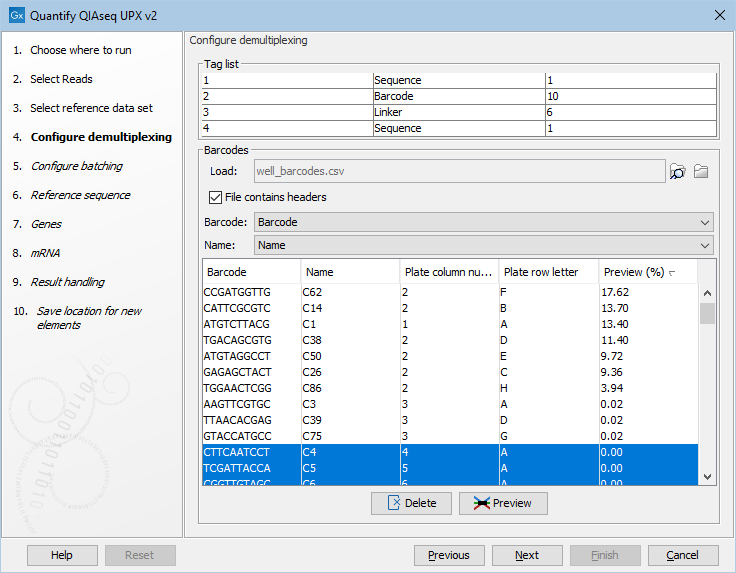Running Demultiplex Reads in workflows
A number of sequencing kits offer indexing kits where barcodes are coded into plate wells, e.g. the QIAseq UPX sequencing kits. Often each individual well has a specific barcode that is always placed in the plate matrix at the same position. Usually different plates are available and plexing can be done for up to 386 wells (4 x 96 different plate well designs). When running these protocols demultiplexing directly on the sequencing machine is not appropriate and hence the demultiplexing step needs to be done using the Demultiplex Reads tool instead.
When analyzing multiple samples it is not always that the full 96 samples plate is used. This result in empty wells that needs to be removed. When running the Demultiplex Reads tool in a workflow you get the option to load or import your barcode table, have a preview of what wells have been used and you are given the option to remove the barcodes (wells in the plate) that have not been used, or that for some reason did not produce any or only few reads.
Note that the barcode table for running in workflows can contain more columns, but still need the Barcode and Name column as described in Entering barcodes.
An example of a plate design as well as the barcode preview is shown in figure 26.28 and 26.29. A Delete button is present and will remove highlight barcodes.

Figure 26.28: The sample design organisation of an experiment not using all the wells in the plate.

Figure 26.29: The barcodes tabel from the experiment in figure 26.28 loaded and showing a preview. Note that the highlighted barcodes can be deleted using the Delete button.
Use the preview functionality to identify barcodes matching reads. When the Preview column is empty you can fill in the percentages by selecting the preview button and the selecting the reads. Use sorting by ticking the Preview column header to rank the barcodes according to percent reads per barcode. It will now be easy to select wells that are not used or have low quality.
You can also just deselect any barcode/well that was not used. For this sorting on plate column number and plate row number as illustrated in fig 26.29 could be helpful.
Note when running the Demultiplex Reads tool in a workflow, an Iterate element is needed just downstream the tool. This is to ensure that all the samples are being processed separately. Furthermore, when running Demultiplex Reads in a workflow you will not be able to perform regular batching and hence the batch tickbox has been disabled, this limitation is caused by the iterative nature of demultiplexing and processing in one flow.
